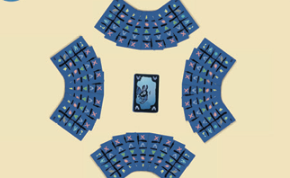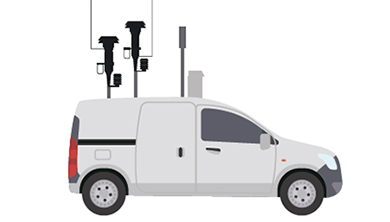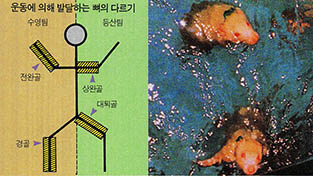전자식 계산기가 처음 등장하여 당시 계산자에 관한 필자의 새책 판매를 망쳐버렸을때 필자는 그 계산기들 속엔 각각 지능을 갖춘 살아있는 바퀴벌레가 있어 작동하는 것이라고 생각했고 또 심지어는 그렇게 활자화하기까지 했다.
바퀴벌레나 컴퓨터에 관해 많이 알지 못하는 필자로서는 그때의 표현이 30여년이 지난 지금도 크게 틀린 것은 아니었다는 생각이다. 그와 같은 표현은 작가 돈 마키스가 창조한 그 유명한 아치를 필자가 인상깊게 기억한 데서 비롯됐는데 그 소설속에서 아치라는 이름의 곤충이 지능을 가졌던 이유는 시인이었던 아치의 영혼이 불행하게도 바퀴벌레의 몸으로 다시 태어났던 까닭이었다. 물론 진짜 바퀴벌레들은 시적이지 못하다.
바퀴벌레와 컴퓨터간에 무슨 닮은 점이 있을까? 우선 바퀴벌레는 인류보다 2억5천만년이나 앞서서 존재해왔으나 컴퓨터는 내 나이보다도 젊다. 바퀴벌레의 족보는 대단하다. 생물분류체계로는 절지동물(지구상에 나타난지 6억3천만년이나 되는)에 속하여 유니라미아로 재분류되고 또한 페리고타에 소속되며 그중 곤충류에 속한다. 다른 모든 절지동물처럼 바퀴벌레는 딱딱한 바깥 표피를 지녔으며 땅위에 사는 곤충들이 그런 것처럼 밸브가 있는 공기통으로 숨을 쉰다. 바퀴벌레의 신경계는 신경절이라 불리는 신경세포들의 뭉치가 쌍으로 연결됨으로 만들어졌다. 머리속의 가장 큰 신경절이 감각을 받아들이고 명령을 내리지만 머리가 완전히 짓밟혔을 때는 흉부나 복부속의 신경절도 근육을 수축시키기에 충분하도록 크다.
모든 곤충들은 외골격과 숨통을 가능한한 작게 만드는 것 같다. 작은 생물의 경우 큰 두뇌를 발전시킬 수는 없으나 컴퓨터의 반도체 칩처럼 각각이 힘을 합해 집합으로 활약한다면 놀랄만한 일들을 할 수 있다. 벌이나 말벌이나 개미처럼 무리지어사는 곤충들은 난해한 통신수단을 통해 복잡한 사회를 형성한다. 바퀴벌레는 그렇지 못하지만(제발!) 과학자들은 바퀴벌레의 조상이 무리지어 사는 곤충으로서 자신들을 위한 큰 건축물을 조립하거나 우리의 집을 갉아내리는데 숙련되어 대단한 평가를 받고 있는 흰개미라고 믿고 있다.
바퀴벌레가 필자로 하여금 작은 기계들을 연상시키기는 하지만 바퀴벌레들은 기계보다는 훨씬 빨리 배운다. 공기와 표면의 진동에 민감하여 그들은 우리를 피하고 심지어는 우리가 독약을 놓아둔 곳을 피하는 법도 배운다. 개개의 바퀴벌레는 4년이상을 살면서 1천개의 알을 낳을 수도 있다. 바퀴벌레는 인간이 사는 곳이라면 어디서나 찾을 수 있으며 성공적인 삶을 누리고 있다. 이제 컴퓨터도 마찬가지다.
필자는 컴퓨터를 이용하면서도 아직도 그속에 아치가 들어 있다고 믿어 컴퓨터 전문가인 처남에게 전화를 걸어보았다. 그 결과 현대의 컴퓨터는 집적회로 실리콘 칩이라는 반도체에 의존하는데 그 모양은 조그마한 정사각형에 작은 다리가 많이 달렸음을 알게 되었다(6개의 다리밖에 없는 바퀴벌레보다는 지네에 더 가깝지만). 반도체 칩들이 냉장고 밑을 기어다니지는 못하는데 그이유는 그들의 다리가(입출력을 위한) 칩들을 연결시키는 가는 금속선들이 있는 회로판에 납땜질되어졌기 때문이다.
각 칩은 적절한 전자 속성을 지니도록 얇은 실리콘 층으로 처리되어 만들어졌다. 회로축소사진은 칩의 금속판 층들에 에칭하는데 활용되어 수천만개의 회로들이 하나의 칩에 들어감으로써 엄청난 양의 입출력을 다룰 수 있도록 하였다. 각 보드는 여러개의 칩들을 포함한다. 회로에칭을 위한 전자광선과 X선을 이용한 신기술로 앞으로 컴퓨터 부품들은 더욱 작아지고 더욱 많은 것을 포함하여 컴퓨터의 힘을 증가시킬 것이다.
필자의 두뇌는 처남이 논리게이트를(밸브식인 네가지 유형의 논리게이트로 컴퓨터가 제작될 수 있다) 언급하면서부터 그만 포화상태가 되고 말았다. 필자는 바퀴벌레들이 간단하지만 효율적인 조그마한 기계들로 연상되고 자꾸만 그 흰개미의 후손들이 화학처리에 의해 칩으로 연결된 것처럼 생각되었다.
최근 필자는 실제 신경세포들의 기능적 속성을 닮았고 이온전류로부터 신경자극을 만들어내는 아날로그형 집적회로인 '실리콘 신경'의 개발에 관해 읽어봤다. 컴퓨터 기술자들은 심지어는 실리콘 신경원들을 하나의 마이크로 칩으로 집약시키고 이 칩들을 연결시켜 정보를 처리하는 두뇌의 유기적인 활동을 흉내내기 위해 노력하고 있다.
이제 우리는 마빈 민스키가 불렀던 것처럼 '신경회로망'을 만드는 방향으로 나아가고 있는 듯하다. 컴퓨터는 흔히 한번에 한가지를 다루는 직선형으로 문제를 풀어나가지만 신경회로망 컴퓨터는 문제의 부분들을 다른 프로세서와 연결되어 있는 하나의 조그마한 프로세서에 맡길 수 있다.
만약 인간두뇌속의 신경원들이나 흰개미기둥의 개미 하나하나사이의 활동을 통신을 통해 조직화시킬 수 있다면 인공신경회로망의 통신은 훨씬 수월해져서 컴퓨터는 기막힌 일들을 수행할 수 있게 될 것이다. 곧 이 인공기계는 뇌를 그대로 닮게 될 것이다. 하지만 누구의 뇌가 될까?
마이크로칩은 이론적으로는 영원불멸 하지만 열을 받아 파손당하고 힘을 받으면 깨질 수도 있다. 바퀴벌레 한마리는 짓밟힐 수도 있고 여러마리는 약을 먹고 죽을 수도 있지만 그 패거리는 인간보다 훨씬 오래 살 수 있다. 지능을 갖춘 컴퓨터도 과학소설 속에서는 인류보다 더 오래 살기도 한다.
그러나 낙심할 것까지야 없다. 바퀴벌레와는 달리 마이크로칩은 스스로를 재생시키는 법을 모르니까 말이다. 아직까지는.
When the first electronic calculators appeared-and wiped out sales of my then new book on the slide rule-I thought and even said in print that for all I knew, the things worked because each contained a particularly lively and intelligent cockroach.
Thirty years later the description doesn't seem far off to me, given the little I know about cockroaches and computers. My original remark was prompted by fond memories of Don Marquis' famous Archy, but that literary insect was intelligent because he was a poet whose soul had unfortunately "transmigrated" into the body of a cockroach. Real cockroaches are not poetic.
Are there any similarities between cockroaches and computers? To begin with, cockroaches have been around more than 250 million years longer than humans have existed, and computers are younger than I am. The cockroach pedigree is impressive-phylum Arthropoda (on Earth for 630 million years), subphylum Uniramia, subclass Pterygota, class Insecta. Like all arthropods, cockroaches have a hard outer skeleton, and like terrestrial insects, they breath through air ducts containing valves. Their nervous system is a double chain of nerve cells in bunches called ganglia. The biggest ganglion in the head receives sensory input and sends instructions on, but the ganglia in the thorax and abdomen are also large enough to contract muscles even when the head has been thoroughly stepped on.
Exoskeletons and air ducts ensure that all insects have to be relatively small. Large brains can't develop in very small animals, but in the aggregate-as if the individuals were linked like chips in a computer-some insects do astonishing things. Social insects like bees, wasps and ants build complex societies with intricate communication. Cockroaches don't (I hope), but scientists believe that they are the ancestors of an impressively social insect-the termite, adept at building edifices of their own, or tearing ours down.
Cockroaches remind me of little machines, but they learn faster than our machines do. Sensitive to vibration of air and surfaces, they avoid us, and even learn to avoid places where we've usually put poison. An individual cockroach lives over four years and may well lay 1,000 eggs. Cockroaches are found almost any place where humans can live. However unintelligent, cockroaches are successful. So are computers.
I use a computer but still suspect there's an Archy inside, so I called my brother-in-law, a computer maven. I learned that modern computers are based on integrated circuit silicon chips that look like little squares with a lot of tiny legs (more like millipedes than cockroaches, which make do with six legs). They don't run under the refrigerator because the legs (for input and output) are soldered into a circuit board that contains thin metal strips to connect the chips.
A chip is made of thin silicon layers treated to give the right electronic properties. Circuit microphotographs are used to etch circuits on the chip's layers, so many thousands of electronic circuits go on one chip, enabling it to handle a great deal of input and output. A board may contain many chips. With new techniques using beams of electronics and X-rays to etch circuits, components will be made smaller so even more will be packed in, increasing the computers power.
My brain went into overload by the time my brother-in-law got into logic gates (out of four types of logic gates—like valves—you can build any computer). I kept picturing cockroaches as simple but efficient little machines, and their termite descendants as chemically wired-together chips.
Lately I've been reading about the development of "silicon neurons," analog-integrated circuits that approach the functional characteristics of genuine nerve cells, which handle ion currents to produce nerve impulses. Computer engineers are even now trying to combine many silicon neurons onto one microchip, connecting the chips to imitate the way organic brains process information.
It seems that we're on the way to making what Marvin Minsky has called a "neural net" Computers usually work on a problem linearly, one thing at a time, but a computer with a neural net can assign parts of a problem to little processors that are connected to all the others.
If communication organizes the activities of the neurons in a human brain or the individuals in a termite hill, the ease of communication in an artificial neural net should do wonders for computers. They'll learn fester, and better. Soon these artificial gizmos will imitate brains—but whose?
The microchip is theoretically immortal but it can be damaged by heat or cracked if sufficiently assaulted. One cockroach can be stepped on, many poisoned, but the clan is all too likely to outlast the human one. In science fiction, intelligent computers outlast humans, too.
Cheer up. Unlike cockroaches, microchips don't know how to reproduce by themselves. Yet.
(c) 1992, Los Angeles Times Syndicate
이 기사의 내용이 궁금하신가요?
기사 전문을 보시려면500(500원)이 필요합니다.
1992년 04월 과학동아 정보
🎓️ 진로 추천
- 컴퓨터공학
- 전자공학
- 생명과학·생명공학

















